The AGFA Karat was a series of strut folding compact cameras made from the mid 1930s through the mid 50s. The earlier models used a unique type of Rapid film made by AGFA for this camera. It differed from Kodak’s 135 format 35mm in that the cassettes were smaller and the camera would spool from a full cassette directly into an empty cassette. The Karat 36 rangefinder was introduced in 1948 and was the first in the Karat line to use traditional 135 format 35mm film. It has a unique single window split rangefinder and combined viewfinder which was not typical of cameras of the era. Although still technically a folding camera, it is a well built German rangefinder with a solid shutter and a good lens, which makes it capable of excellent shots.
Film Type: 135 (35mm)
Lens: 50mm f/2.8 Schneider-Kreuznach Karat-Xenar coated 4 elements
Focus: 3′ to Infinity
Type: Coupled Rangefinder
Shutter: Compur-Rapid leaf
Speeds: B, 1 – 1/500 seconds
Exposure Meter: None
Battery: None
Flash Mount: PC Sync and Cold Shoe
Manual: http://www.butkus.org/chinon/karat_36/karat_36.pdf
History
AGFA is a German acronym for Aktien-Gesellschaft für Anilin-Fabrikation and was founded in Berlin in 1867. The company’s first products were chemicals used in photography. AGFA first patented Rodinal, which is an agent used when developing black and white film, in 1891 and is still in production today.
In their earlier years, the company expanded into making a variety of photographic products in the early 20th century. In 1925, AGFA acquired the German camera company Rietzschel, and their first product, the AGFA Standard was released a year later. By 1927, the name Rietzschel disappeared from all marketing and products, and in 1928, AGFA partnered with the American company ANSCO to manufacture it’s products for the American market.
Like Kodak, some of AGFA’s earliest products were basic box cameras which were sold for very little. The idea was that if they could get people to buy their cameras, the company would continue to receive profits from sale of AGFA film. This concept worked well and made AGFA one of the most successful camera companies in pre-WWII Germany.
In the 1930s, the concept of smaller cameras was gaining popularity in the world. Leitz had the Leica, and Zeiss-Ikon had the Contax which both used an early form of 35mm cinema film. In 1934, Kodak would introduce the new daylight loading cassette which was known as 135 film.
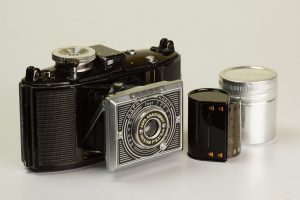
Since both AGFA and Kodak made both cameras and film, they were seen as direct competitors, so it was in AGFA’s best interest to develop their own 35mm film that competed with Kodaks 135 format. AGFA responded in 1936 with the release of the AGFA Karat and its own version of 35mm film cassettes. The major difference between Kodak’s 135 format and the AGFA Karat system is that the Karat used a “cassette to cassette” system in which exposed film was wound back into an empty cassette. There would be no need to rewind the film at the end of the spool, this offered less chance of accidentally exposing the film during transport.
The AGFA Karat camera was a compact, strut folding camera made primarily out of Trolitan, which was a variant of Bakelite. The first model had an elaborate art-deco pattern on the front plate, and came with a maximum aperture of f/6.3. Later models would abandon the art-deco look and come with faster lenses. The prewar AGFA Karats saw several different variations from 1936 – 1941, when production was halted.
The original Karat continued to be made after the war, but sometime around 1945 a second generation Karat, known as the Karat 2.8 (later renamed the Karat 12) was produced. Getting an exact date for when the second generation models first started production is difficult because some of the parts, like the lenses, were built from pre-war parts. Some Karat 2.8s exist with Schneider-Kreuznach Xenar lenses that date from well before the war. It is possible that some Karat 2.8s were made before the war, but this has never been confirmed.
The AGFA Karat 12 continued to be made until about 1950 when the AGFA Karat cassette system was phased out due to being unable to compete with the huge success of Kodak’s 135 format. In response, AGFA would revise the Karat 12 to use Kodak’s 135 format and would release the new model as the Karat 36 in 1948. Despite the change in film format, the basic design of the Karat 36 was very similar to that of the Karat 12. The most notable change was the new rewind knob needed for 135 format film.
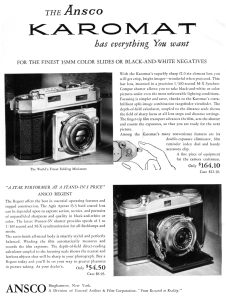
Even after the war, AGFA was still licensing it’s designs to ANSCO so that their products could be sold in the west. The first export models were still made by AGFA in Germany, but called the Karomat 36 and sold primarily in the United States. The ad to the right comes from the February 1954 issue of Modern Photography and lists the Karomat with a price of $164.10 with the top of the line Schneider-Kreuznach f/2 lens. When adjusted for inflation, that is a hefty, $1487 today, quite an expensive camera! Eventually, ANSCO would start producing their own cameras and sold them as the ANSCO Karomat. Other than the name, the AGFA and ANSCO models were identical.
The Karat 36 retained the original strut folding design of the pre-war models. Unlike Kodak’s Retina, when folded, the lens was still visible from the outside of the camera. While this could possibly increase the chances of the lens and shutter being damaged while not in use, by not having a door and using a “scissors” mechanism, the lens mount was more solid and reliable. Many early Retina’s can become jammed if there is any damage to the door, whereas the folding mechanism on the Karat could stand a bit more abuse.
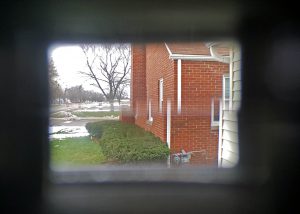
The Karat was a well designed camera with clean lines and an excellent rangefinder. Unlike other rangefinders of the 1940s and 50s, the viewfinder and rangefinder were in the same window. Peering through the rear viewfinder, you would see a single horizontally split image. To focus the camera, you would move the focus arm on the lens which would move the two images in the viewfinder left and right until they lined up. On other 40s rangefinders, once this step was completed, the photographer would have to move their eye to a separate viewfinder-only window to compose the image. On the Karat however, the focused image was the composed image. This sped up the process because the photographer did not have to move his or her eye.
The obvious downside to this was that there was always a horizontal split through the middle of the viewfinder. If your eye was not perfectly centered in the viewfinder, the two images would be hard to see.
As with most 40s and 50s German cameras, the Karat was solidly built with good optics and is capable of excellent images. Also like many AGFA products of this era, the cameras used a “greenish” lubrication that can turn to a sticky mess over time. Many AGFA cameras from this era are often inoperable because the focus becomes so sticky, it ends up having the consistency of glue. Trying to force a stuck AGFA can often have dire consequences damaging some other part of the camera.
While these have the promise to be excellent users, almost any AGFA Karat is going to need some level of cleaning before it can be used again.
Despite this challenge, AGFA Karats are still fairly popular. They have an excellent reputation and are one of the few rangefinders made with the single split image combined rangefinder/viewfinder. Since there are no beamsplitters needed to pass through the reflected image, when cleaned, the viewfinders are often as bright and clear as these cameras would have been when new.
Repairs
I guess its worth mentioning that nothing was actually broken on the Karat when I received it. It’s one and only glaring issue was that the original lube had hardened into a sticky, glue-like substance and it needed to be cleaned. This is very common with all 40s and 50s AGFA cameras. The Karat is not particularly difficult to clean, but it does require a lot of the same common sense steps needed to take apart any camera.
Thankfully, there is an excellent pictoral walkthrough of how to disassemble a Karat on Flickr by PF McFarland. I have used this guy’s walkthroughs before, most recently when I CLAd my Universal Mercury II. This guy has a knack for taking apart cameras and documenting the process.
I will say that for what I needed to do, the walkthrough on Flickr goes into the camera a lot more than I needed. He also took the shutter out in a different order I did.
If the only issue with your Karat is that the focus is stiff and the shutter has no issues, you can completely remove the shutter and front lens assembly from the camera in one piece and leave it all together. You’ll have access to the focus helical which is all you need to clean. I chose to make the extra effort to take apart my shutter for cleaning since some of the speeds seemed to be slow. Even if the speeds weren’t slow, its still a good idea to clean any 60+ year old shutter.
Before you attempt to remove the shutter, you should set the focus to infinity. This will help when you reassemble the camera later on.
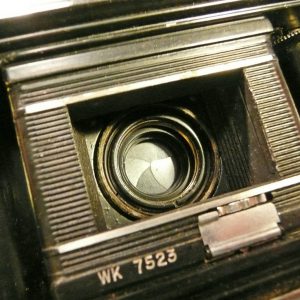
The first step to removing the shutter is to unscrew both the rear lens retaining ring and the shutter retaining ring using a lens spanner tool. Both are easily accessed through the back of the camera. It helps a great deal to make sure the front of the camera is in the closed position. Using your spanner, loosen both rings, taking care not to scratch the glass lens and remove the glass and both rings.
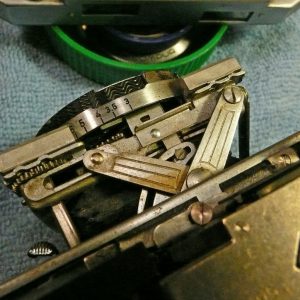
After taking out the rear rings, there is one more screw to remove at the top of the camera. Extend the front of the camera and you’ll see the screw in a curved metal channel. This screw is attached to a spring loaded lever which is what moves the rangefinder when the focus is turned. When you remove the screw, this piece of metal will spring back into the camera which is OK. It will not fly out of the camera.
With both rear retaining rings, the glass element, and the rangefinder screw removed, the whole shutter assembly should come out of the camera. It might get hung up on the shutter release, but just wiggle it until it comes out.
Once you have the shutter out, you will see the focus helical. There is a divot in the helical that should always remain in the 12 o’clock position when the focus is at infinity (which it should be already). The helical will just screw out with your fingers. Depending on how stuck it is, you might need to help it by sticking a small screwdriver in the divot and “turning” it out.
Once you have the helical out, clean, clean, clean it. When you are done, clean it some more. Keep cleaning it until no more grease, green goo, or anything rubs off it.
While I am a big proponent of NOT lubing any part of a camera, the helical is one area where a bit of lube will help. There are a variety of opinions on what the best lube is. Some people will use a watchmakers oil, some say synthetic grease works, and some say white lithium grease from an auto parts store is good. I have used white lithium grease on a variety of cameras and have never had a problem. The key is to use it SPARINGLY.
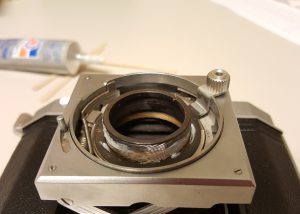
In the picture to the left, I have WAAAAYYY too much grease on the helical. I later wiped off a majority of this before reassembling the camera.
When reinstalling the helical it is very important to install it correctly so that when the divot is at the 12 o’clock position, the top surface of the helical should be about 1 mm above the surface of the body of the camera. If the helical is too far above the surface or below it, your infinity focus will be off. If you did not pay attention to how this came off, and aren’t sure, then you will need to do it trial and error and then collimate the lens to check for infinity focus. This isn’t hard to do, but it’s just another step.
Assuming you got the helical installed into the camera correctly, you can reassemble the shutter in the same way you took it out. If you plan on cleaning the shutter with Ronsonol, this is a good time to do that because it is always better to soak a shutter outside of the camera, rather than in it.
I cleaned my shutter using a Ronsonol bath like I have done on several other cameras. I won’t go over the process here again, but I’ll just say, it takes many cycles of soaking, wiping, and then letting it dry and repeating. Don’t try to use compressed air to speed up the drying, and do not use anything other than lighter fluid or naphtha oil to clean the shutter. After a couple days of cleaning it, check to make sure the shutter works at all speeds and install it into the camera.
When installing the shutter, the most difficult part is getting that spring loaded lever for the rangefinder back into position so that you can put that one screw back in. I used a combination of toothpicks and two screwdrivers to pull the lever out of the camera while trying to tighten the screw. I was able to do it myself, but it might be easier if you have someone else help you.
For more detailed pictures and an explanation of how to disassemble the shutter, refer back to PF McFarland’s instructions on Flickr.
I also cleaned my viewfinder and the rangefinder windows by taking off the top plate. Although there are instructions for this in the same tutorial, you really don’t need them. It is very easy to do on the Karat. Remove the rewind knob by sticking something into the fork and unscrewing it, and remove the 3 visible screws on the top plate and the whole plate will come off. If you do remove the top plate, pay attention to the front glass windows. That glass is actually just one long piece and it was loose on mine. I cleaned it and put it back in before replacing the top plate.
Once I had my camera back together and I confirmed the shutter still worked, my focus was correct, and the viewfinder was clean and bright, I loaded in some film and went shooting!
I could probably summarize this entire review with just two words:
German Rangefinder
Its not easy to find new ways to keep saying the same things about these mid century German cameras. Their build quality and designs are almost always excellent. The Germans have consistently had a very high quality standard, so much so that even in 2015, their cars are still considered to be some of the best out there.
This particular example came to me in the way of eBay. While I wasn’t looking for a Karat, and even if I was, I probably wouldn’t have paid a lot for it, but this one was especially cheap because of the frozen focus. The seller listed the lens as being “extremely stiff” and that must have driven everyone else away because I was the only bidder at $9.99. I took a chance that I could clean it up and get it working again, and thankfully, I was right.
In doing research on when my example was made, I found CJ’s Classic Camera Collection which is an excellent resource for classic cameras, especially the Karat.
CJ lists the Karats by their design revisions. The earliest Karat 36 is version 1 and had a fold down winding lever and fully exposed exposure counter. He says that in 1951, the design changed slightly to included a rounded “unfoldable” winding lever and a redesigned top plate which has a partially covered exposure counter.
Mine seems to have characteristics of both versions, so I officially call mine a v1.5 camera. I emailed CJ with some pictures of my camera and asked his opinion. His response was:
Hi Mike, thanks for email, it is always nice to hear my website is being appreciated!
As to your Karat (which looks to be in very good shape!), you are right, it is a 36 v1 but has a round instead of a flat wind lever knob. I have seen a few of those but not many. I guess there are two options, Agfa introduced the round knob at the end of the production of the v1, before they changed the rest of the top housing, or the camera has been repaired at some point with the later wind knob. I don’t have enough information to be sure.
If you can send me the body serial # (when you open the back, something like XY 1234), the lens serial # and the shutter serial # (7 digits visible on the shutter housing when you change the camera focus to 3 ft), I can probably give you a better estimate.
The Xenar, by the way, is also fairly uncommon on this model, most had Heligon or Xenon lenses.
Best wishes,
Cees-Jan
I responded with the serial numbers he requested and this was his second response:
Hi Mike,
Sorry for my late reply, it’s been a hectic week. Also, it turns out your camera is a bit of an enigma. Lens and shutter serial numbers are consistent with the camera being build around mid 1950, which is at the end of Karat 36 v.1 production, as expected. The body number seems later even that v.2 though. Perhaps Agfa did not number the bodies very consistently.
The Xenar is not as highly regarded as the Xenonor Heligon lenses, but nevertheless considered a very good performer and better than triplet lenses found on many other cameras from that era (Cassars, Reomars, etc).
Hope you’ll get some nice pictures! It’s great fun to use those old cameras.
Best wishes,
Cees-Jan
So, do I have a “Franken-camera” put together or previously repaired using spare parts from different years, or is mine some type of rare transition model made between v1, and v2? I guess it really doesn’t matter. Nevertheless, it seems certain that mine was made sometime around 1950.
When picking up an AGFA Karat for the first time, you should already have a reasonable idea of what to expect in terms of quality of the camera and what kinds of pictures it will make. Like with any old camera, the “devil is in the details” and thats what makes this camera interesting.
For one, it is the only camera in my collection with a wind lever that goes from right to left. I am not sure why they designed it this way because it’s resting position keeps it on the outside of the camera, rather than behind it like on a more traditional design.
The other peculiar design element is a folding piece of metal inside the film compartment that helps provide tension on the film while passing through the film sprockets. Most cameras position the sprockets immediately next to the takeup spool to help guide it onto the spool, but on the Karat, the sprocket is below the film opening.
I have never seen a Karat that used AGFA’s original proprietary film cartridges, but Cees-Jan de Hoog of CJ’s Classic Cameras tells me that the original film did use the same sprocket holes as 135 film and the location of this sprocket was to aide the AGFA film into the takeup cassette. The location is not an issue for 135 film, but you have to remember to fold this piece of metal up when loading film and back down again before closing the back of the camera.
I already talked briefly about the combined viewfinder and rangefinder which works quite well, but does require precision positioning of your eye. Everything else about using the camera is about what you would expect.
The release catch to extend the front lens is spring loaded and pops open the front of the camera with a good amount of force. No assistance is needed to help get the camera into shooting position. Once the lens is extended, it is in a locked position, so you need to activate the release catch a second time in order to close it.
My Results
On paper, this camera compares very favorably to the Kodak Retina. Both are German made compact folding 35mm rangefinders based on a pre-war design. They’re about the same size, same weight, and even have comparable lenses.
So, it should be no surprise that the performance of the two cameras should be the same. Well, sometimes things on paper don’t turn out like that in real life, but sometimes they do. In this case, they did.
The AGFA Karat 36 is a wonderful camera which produced excellent shots with great color, contrast, and sharpness on my very first roll. This was especially surprising considering how deep I had to go into the camera to get it working. I had to literally guess at the position of the lens helical and use my makeshift collimation technique to see if I got it right. Well, I did.
| My Final Word | The AGFA Karat 36 certainly has it’s following, but it’s not a big one. In vintage camera circles, you will often hear of the Kodak Retina many times more often than the Karat, but thats not because of any fault of the capabilities of the camera. This is a wonderful camera that deserves a spot in any collection. The biggest obstacle to owning and shooting one is the sticky focus. Almost every one out there will have this issue, which requires a cleaning. If you are patient, have the right tools, and a free night, you can clean it yourself. Trust me, the effort is worth it. As much as I love my Retina, I find the split view rangefinder window to be much easier to focus than the dim circle from my Kodak Retina IIa. This is a camera I will shoot with again. | ||||||
| Images | Handling | Features | Viewfinder | Feel & Beauty | History | Age | |
| 2 | 1 | 1 | 2 | 1 | 1 | 30% | |
| Bonus | none | ||||||
| Final Score | 10.4 | ||||||
Additional Resources
http://www.cjs-classic-cameras.co.uk/karat/index.html
http://camerapedia.wikia.com/wiki/Agfa_Karat
http://camera-wiki.org/wiki/Karat
https://simonhawketts.com/2017/02/22/cleaning-servicing-agfa-karat-12-film-advance/
http://www.karat-kameras.de/frameset.htm (in German, use Google Translate)

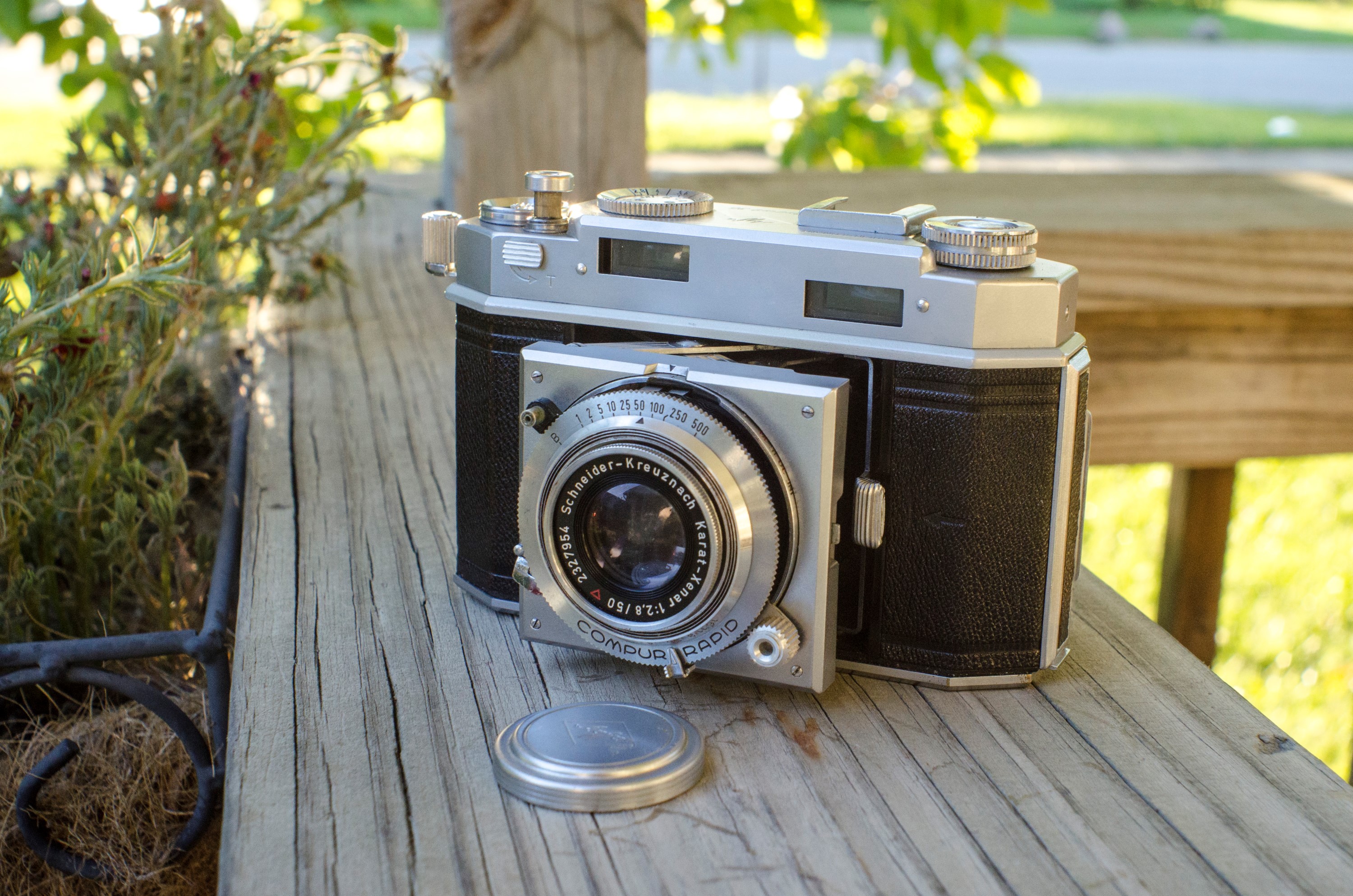
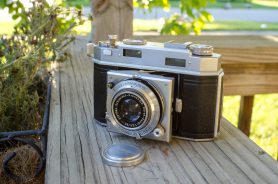
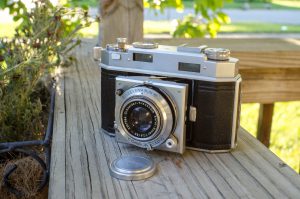
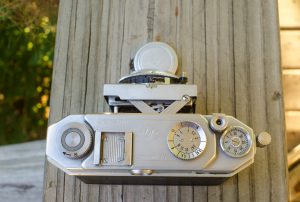









Hi Mike
I have recently bought an Agfa Karat 36 very similar to the one you show; it’s the same on pretty much everything (Xenar 2.8 / 50 lens, rounded advance lever, tab for T position, etc.), so I don’t think yours is a “Frankencamera” if not one of the many variations Agfa produced. My question is if you have found out the existence of a rule to deduce from the serial number (mine has XE 1754) a date of manufacture, or is there a list somewhere with such a correspondence.
Thanks and kind regards.
Luis
Hi Luis, I made that comment when I wrote that review based on research I had done on CJ’s Classic Cameras. His site does a good job of showing all the different variants of the Karat/Karomat, but definitely not all of them. I think back then, it was common for companies to produce a bunch of parts. When a part would be updated, they would just update one part, but sometimes still have old parts left over, so there would be transitions where an updated new part gets combined with an older body or older part. Back then, people like us obsessing over versions didn’t exist, there were just people who wanted to make photos, so no one cared if a camera had a 1950 film advance lever with a 1951 shutter, or rewind knob! 🙂
And sorry, no. I’ve never found a dating system for the Karats, like other companies have. Some companies just didnt keep records like that, but I wish they did!
I think that what you propose is the most reasonable.
Thanks Mike
I’ve read online that the Karat-Xenar (or at least some of them) actually are of the 5/3 “Super Xenar” variety rather than the standard 4/3 Tessar, but I also often see it designated as a classical Tessar lens in many spec sheets, I wonder which is the rumour and which the truth. Lens disassembly should clear it up, but my Karats are still fully working so I wouldn’t like to mess them up 😛
I agree, there is a lot of misinformation out there for lens element layouts. I don’t even know that I always get it right, but I try to include what I think is the most accurate information. If you ever learn otherwise, please let me know and I can update the article.